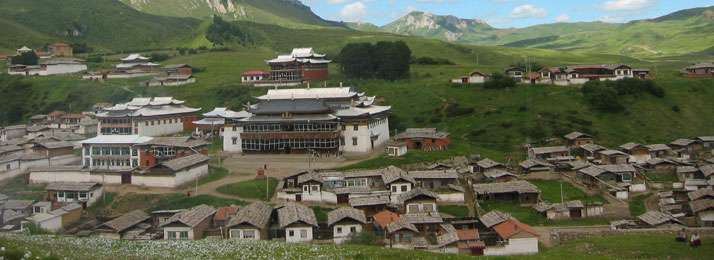
Langmu Monastery is located between Gansu Province and Sichuan Province in Southern Ruoer Gai County. It is not only a name for a monastery, but also a name for a township where Buddhist and Islamic believers live a leisurely life style. A river, Bailong River, separates the township into two parts: one part in Gansu and another one in Sichuan. Langmu monastery is a place where you can experience both Tibetan Buddhism and Islamic culture since there are two Tibetan Buddhist monasteries and one Islamic temple located in Langmu Township. Historically Langmu monastery was the center of local religion, culture, economy and politics. Langmu Monastery’s whole name is “Dacang Lamu Gerdeng Monastery”. In the Tibetan language, Dacang means Tigers’ den. According to legend it got this name because there is a big hole which was called the “tiger’s den” where many tigers lived. Langmu means fairy maiden because many stones in the cave look like pretty girls. So the name “Dacang Langmu” can be translated as “a fairy maiden in the tiger’s den”.
The two Tibetan monasteries are very famous Gelu monasteries named Kerti Gompa and Serti Gompa. Kerti Gompa is the biggest and most impressive Gelu Monastery in whole Aba area and belongs to Sichuan province since it is located on Sichuan’s side of the river. In 1413, the first Kerti incarnated lama named Kerti Jiangcan, built a small hermitage in Dacang Langmu. In 1713, the second lineage of Kerti incarnated lama named Tala built a small temple. And later the incarnated lama named Quzong established a small temple again in the same location. The fifth lineage of Kerti the incarnated lama named Dengbi Jiangcan put these three small temples together and expended the monastery in 1748. At present this monastery is composed of five temples, one monastic college and about 650 monks.
Behind the Kerti Monastery there is a gorgeous and sacred gorge. The source of Bailong River is in this beautiful rocky gorge. It is also the location of the famous “Tiger’s den,” as well as the caves of the fairy maidens. In one of the fairy caves there is a natural Tibetan goddess statue called Palden Lhamo. After about 20 or 30 minutes walk through the gorge, you will reach a broad and beautiful grassland.
Serti Gompa belongs to Gansu province and is on the Gansu side of the river. The monastery dates from 1748 AD and is simply referred to as Gansu monastery. This monastery has about 300 monks. To the south of the monastery, about a twenty minute walk, is one of the locations of Tibetan sky burials. If you would like to learn more about how death is handled in Tibetan culture you are welcome to visit this site.
